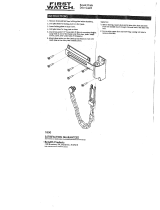
Determining Your Threshold Conguration
2
Look at your existing entry door threshold and use the diagrams below to determine which threshold conguration best applies
to your entryway. This will determine whether a bottom bar is or is not required for your security door.
The concrete extends at least
7/8" further than your trim.
The existing threshold sticks out
beyond the trim by 3/16" or less.
The existing threshold extends
beyond the trim by 7/8" or more.
The concrete and threshold sets
back behind the trim.
The concrete is set back and lacks
space to mount to the threshold plate.
The existing threshold extends past
the trim between 3/16" and 7/8".
Preparing Your Security Door
3
Glass Removal
If your door includes glass, remove it before
you start the installation procedure. Loosen
(do not remove) each screw. Carefully hold the
glass panel in place and rotate each clip 90°.
Carefully remove the glass panel and store it in a
safe place during installation.
Handleset Attachment
Following the manufacturer's instructions,
install your choice of 2-3/8" backset handle
and lock set (Sold separately). Fully extend
the lock bolts into the "locked" position on
the security door (B).
Rotate
clips 90°
Installing the Hinge-Side Jamb
4
For Left Swing Door For Right Swing Door
Primary
Entry Door
Primary
Entry Door
Jamb mounting
Position hinge-side jamb (A) on the desired side of the opening for
your door swing. Allow for a 1/8" gap between the hinge-side edge of
jamb and inside-edge of your mounting surface.
Note: There should be a minimum of 2-3/4" space below the hinge
side jamb and below the entire width of the door to allow space for
the bottom bar (attached in Step 7). It is okay to move the doors
up within the doorway to ensure this space, as long as the top of
the jambs do not go beyond the top-edge of your trim framing. If
a 2-3/4" space exists across the entire doorway, skip to the next
paragraph. Otherwise, position bottom bar (E) on the ground in front
of the doorway with the legs pointing up. Position the hinge-side jamb
assembly (A) on the inactive side of the door, sliding the jamb over the
bottom bar leg to correctly position the jamb. This alignment will be
repeated for the active side jamb. See diagram below:
Important: All jambs must be positioned to allow secure mounting to
your trim framing around the opening.
Make certain hinge-side jamb is plumb. Mark the location of the 1 & 2
mounting holes for hinge-side jamb, by inserting a screw through the
jamb and either making a dent or scratching the mounting surface.
Set the hinge-side jamb aside and, where marked, pre-drill the two
holes, using a 3/16" drill bit.
Support Jamb with temporary screws:
Return the hinge-side jamb to position, verify again that it is plumb,
and install two of the #10 3-1/2" dry wall screws (K) supplied into
holes 1 & 2 (see diagram at top left), and temporarily mount the hinge-
side jamb (A). These screws are inserted only to hold the security
door frame plumb while test tting the door, and will be removed and
replaced with one-way screws, later in this step.
Hang the door to test t:
Holding the door open at more than a 90° angle (see diagram at
center left), hang the security door (B) onto the hinge pins of the
hinge-side jamb (A), starting with the bottom pin rst (see diagram at
bottom left). Ensure that door is fully seated on hinges.
Place a level across the top of the door, to verify that the security door
is level, then re-verify that the hinge-side jamb has remained plumb
during the hanging of the security door. The door will be removed in
Step 6, then reinstalled in Step 9 . If the door is not plumb vertically
and/or horizontally, remove door panel and re-position jamb.
Hinge side jamb installs
opposite entry door handle
Note: verify
that direction of
hinge pins match
illustration
This side up
1
3
4
2
A
More than 90°
Top View
A
B
Jamb-side
hinge
Door-side
hinge
A
B
Hinge side jamb installs
opposite entry door handle
Note: verify
that direction of
hinge pins match
illustration
This side up
1
3
4
2
A
More than 90°
Top View
A
B
Jamb-side
hinge
Door-side
hinge
B
A
E
A
C
Insert bottom bar legs into the left
and right door jambs
Bottom Bar Required Bottom Bar NOT Required
Page 2
Continued








